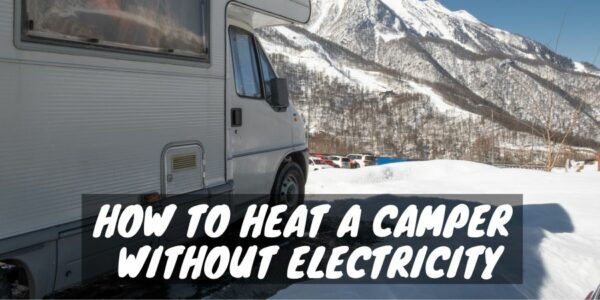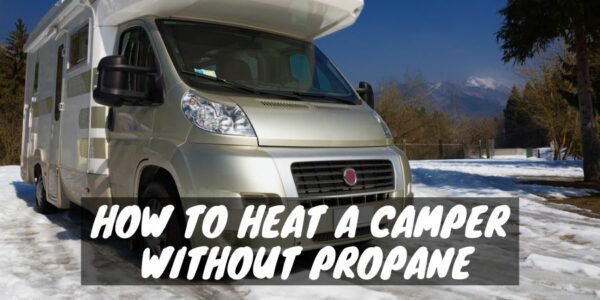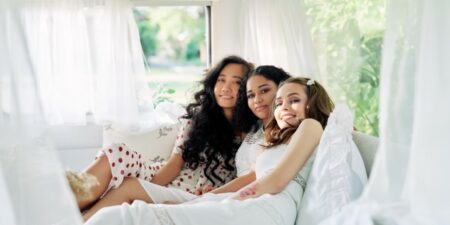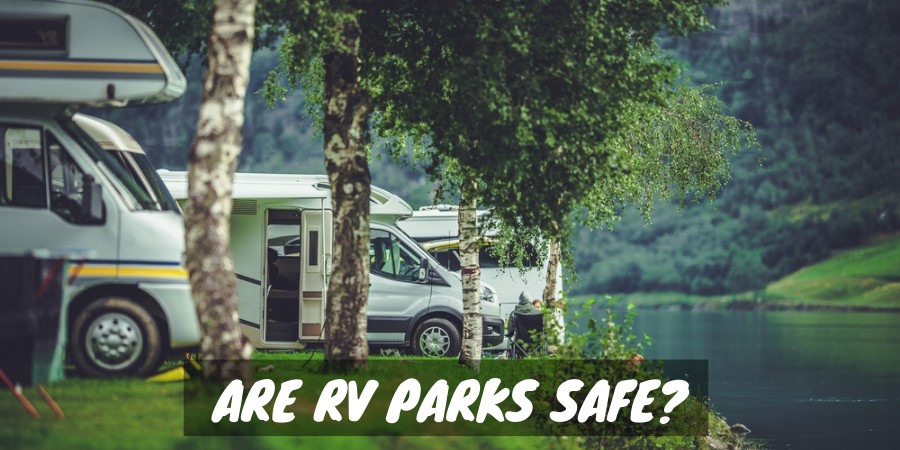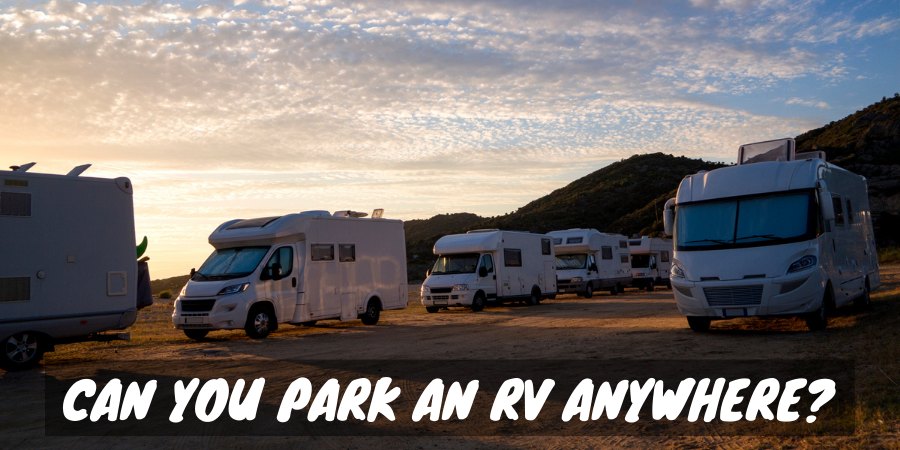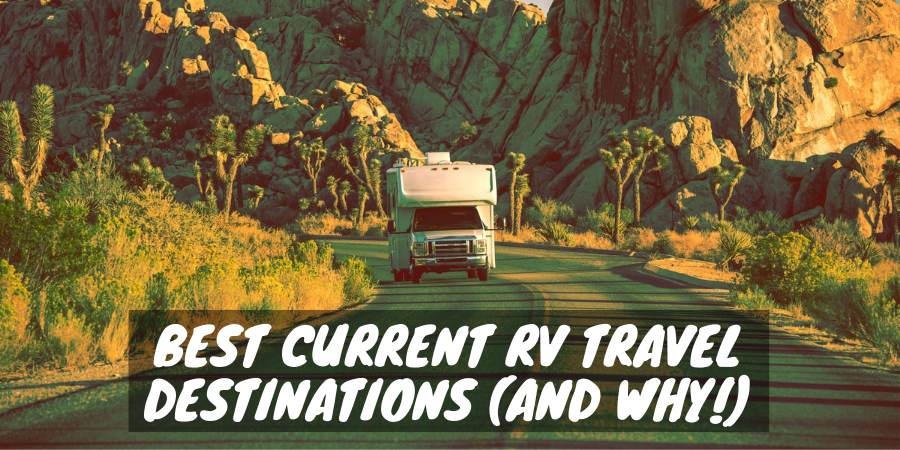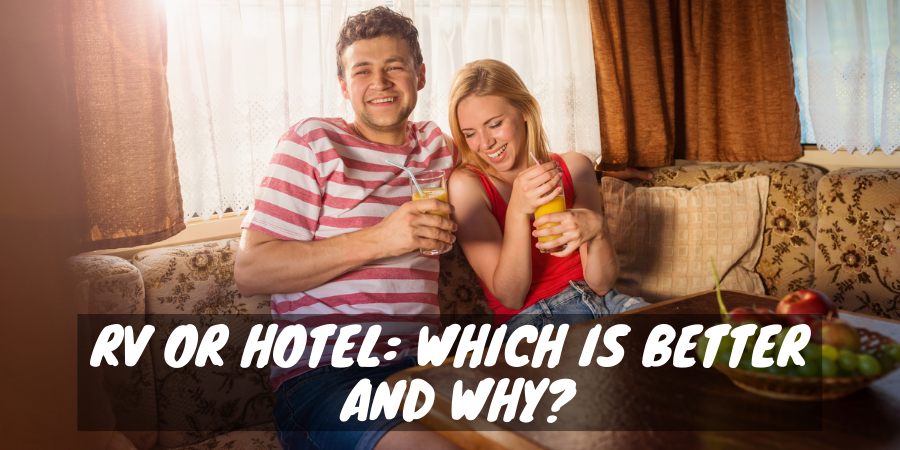Trying to stay warm can be challenging if you love cool-weather camping, but your destinations don’t have the electricity to run a heater. The solution to this issue is to find alternate ways to heat your RV. To assist, we put together the best and safest options below for all types of recreational vehicles.
Keeping your camper cozy and warm without electricity when the temperatures drop can extend your camping season, so it’s worth knowing all your options.
The 3 Best Ways To Heat A Camper Without Electricity
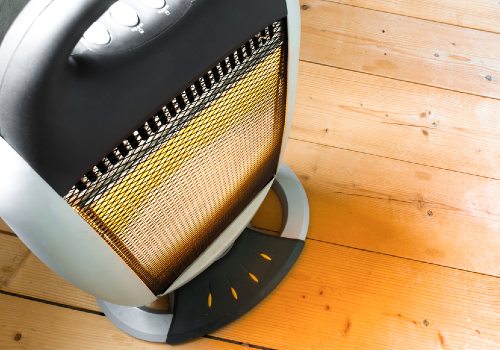
1. Run the RV Furnace
If your camper has a furnace, it most likely uses propane as a heat source, which you can run as long as there is a charge on your house battery.
You may wonder if an RV furnace needs electricity to operate. The furnace does require an electrical power source to start the igniter and fans, but the system can use the 12-volt power from the house battery for these tasks when the RV isn’t on shore power.
Of course, you’ll need to ensure you have enough propane and battery power to keep the furnace running so the camper can stay warm.
We are often asked, “How long will my RV furnace run on battery power?”
The answer is that with a full charge on a deep-cycle 12-volt battery, a propane furnace will operate for about 11 hours. Depending on your camping situation, you may need to bring a secondary charged battery to keep the heat on while the first battery recharges via a solar panel, generator, or power station.
RV Furnace Operation (Video)
As for propane use, a single 20-pound tank should run a 50,000 BTU furnace for six to eight hours of continual operation. Luckily, many modern RVs have better insulation, so the furnace only needs to kick on the burner a few times an hour to maintain interior warmth. This run time reduction of the burner means the propane tank should last much longer than eight hours.
However, that doesn’t take into consideration the use of propane for other RV tasks, such as cooking or running the water heater or refrigerator. Having an extra propane tank or two for heating on extended camping trips is smart if there isn’t a refill station near your campground.
2. Use a Portable Gas Space Heater
If you want to know how to heat a teardrop trailer, pop-up camper, or other travel trailer or motorhome without a furnace or electricity, the easiest way is to use a portable gas space heater.
Portable camping heaters typically run on propane or butane canisters you attach to the heating unit. The heaters run very efficiently to conserve fuel and reduce harmful emissions that form as the gas burns. Most portable heaters will operate on a canister of fuel for between three to seven hours, depending on the heat level, so ensure you pack enough spares to last your entire trip.
Portable Gas Space Heater (Video)
Using a camping heater will require the following safety precautions: cracking a window for ventilation, installing a CO2 detector in your camper, and keeping the unit safe from flammable materials or kids and pets. Depending on the size of your teardrop, motorhome, or travel trailer, you can find a suitable portable space heater to match the square footage so the entire interior stays warm.
Even a small propane space heater can do a great job providing a heated trailer so you and your camping guests can stay comfortable. However, leaving a space heater on in your RV is never safe if no one is inside to monitor the situation.
3. Install A Wood Burning Stove
Wood-burning stoves are not only safe for RVs when installed properly, but they are also an excellent way to heat a camper with no electricity.
People who often camp in the coldest regions find a wood-burning stove very efficient and budget-friendly since you can scavenge wood to burn for free versus having to pay for propane gas. Plus, many stove models feature a cooking surface and a place to keep coffee or tea hot.
With the correct ventilation, a wood stove won’t choke the RV interior with smoke or soot. Instead, you can enjoy the wonderful flickering flames and crackling of the wood that creates a relaxing atmosphere.
You will need room inside your camper to install a wood stove, but luckily, they come in many different styles, sizes, and fuel-burning options. You can find compact units that burn wood pellets to larger residential-size models that take full-size logs.
Wood stoves require a vent pipe through the camper wall or roof, so it will take more time and work to install and seal off the gaps in the exterior. You’ll also need to have the area around the stove fireproofed and secure it to the floor to prevent movement while driving.
While many people install a DIY wood stove in their RV, leaving it to a professional may be best. Experts understand how wood-burning stoves operate, so they perform to optimal levels while keeping camper occupants safe from fumes, smoke, or accidental burns.
Why You Should Upgrade in RV Insulation and Weatherproofing
It’s incredible how fast the interior of a standard camper can warm up just from the body heat and breath of the occupants without electricity involved. You can use the information to your advantage if you want a heated trailer on camping trips in the cold months without relying as much on alternative options when electricity isn’t available.
The first step to increasing heat retention inside your camper is to caulk or fill cracks or gaps that allow drafty cold air to enter.
The next step is adding more insulation to the walls, ceiling, and undercarriage where possible. This can be as simple as attaching temporary rigid foam insulation panels over the areas. If you’re doing a major RV interior renovation, you can increase insulation behind the wall and ceiling panels.
Another easy way to keep the cold air from penetrating through vents, skylights, and windows is to add a thermal foil insulation product such as SmartShield. The material comes in sheets or on a roll and is flexible yet firm enough to cut to fit window frames and other areas where you want to block heat loss. If you measure correctly, you can push the material into the space, and it will stay without the need for tape or screws, which allows you to remove it when you want daylight or see out them while driving your camper.
If your RV floors do not have carpet, add area rugs during cold weather. A thick rug will create an extra barrier to trap heat and keep your feet toasty.
Lastly, add or swap thin curtains with ones that offer a thermal barrier. You can close them over the windows and block a surprising amount of cool air. In addition, they work just as well in hot months to stop heat penetration so your RV will stay cooler.
Many people find making these changes inside their camper goes a long way toward keeping the interior much warmer, and then adding in their body heat is enough to raise the temperature to a comfortable level.
3 Best Portable Camping Heaters
The models below are the top sellers for RV use if you’re looking for a portable camping heater.
1. Mr. Heater MH9BX Portable Buddy
- PORTABLE HEATER: Portable propane heater designed for emergency heat,…
- HEAT SPACE: Perfect for heating enclosed spaces up to 225 square feet
- PROPANE GAS: For use with propane gas; Runs off a 1-pound cylinder of…
- FEATURES: Includes Piezo igniter, Accidental tip-over safety shut-off,…
- SPECIFICATIONS: 4,000 or 9,000 BTU per hour; Run time (max BTU): 3…
The Mr. Heater MH9BX Portable Buddy is the best camping heater overall because it combines a compact design, durable construction, excellent safety features, and ample BTUs to warm even larger recreational vehicles.
The heater uses 1-pound propane canisters and can run for 5.5 hours on the low setting. Other top features and specs include:
- Operates up to 7,000 feet in altitude
- Auto shut-off for low oxygen, no pilot light, or if it tips over
- 9,000 max BTUs
- Easy LP canister connection
- Will heat up to 225 square feet
- Wire guard over the heating element
- Impact-resistant housing with a carry handle
Mr. Heater MH9BX Portable Buddy (Video)
2. DeWalt DXH12B Portable Radiant Heater
The DeWalt DXH12B increases heat output and has two ports to connect 1-pound propane canisters so it can run for up to 13 hours. In addition, the unit has a radiant heat element that warms efficiently, with a fan to move the air throughout your camper.
The unit relies on a 20-volt DeWalt rechargeable battery to power the fan and lights. Still, the best part is the integrated USB ports that allow you also to charge up your devices when shore power is unavailable.
- 3 USB ports for charging personal electronics and accessories
- Powerful LED light bar and integrated high-velocity fan
- Dual tank capacity provides up to 7 hours of run-time
- Built-in tip-over safety shut-off
- Quiet and reliable electronic ignition
Other top features and specs include:
- Three heat settings
- Electronic ignition and thermoelectric safety valve
- 12,000 max BTUs
- Dual LP canister connections
- 10.5 x 15.75 x 14 inches
- Low oxygen sensor
- Can heat up to 1,700 square feet
- Certified safe for indoor use
DeWalt DXH12B Portable Radiant Heater (Video)
3. Flame King YSN-CHS10 Propane Radiant Portable Heater
The Flame King camping heater is a great way to heat a camper without electricity and features a compartment to hold a 1-pound propane canister, so it’s easier to move around inside your camper. The heat output is impressive, and the unit can run for two hours on max output or much longer on a lower heat setting.
- SAFETY FEATURES: Built-in Safety Fuel Shutoff, Oxygen Depletion System…
- FULL COMFORT: Built-in Auto ignition and Thermostat Dial for added…
- ADVANCED THERMOSTATIC TECHNOLOGY: The Thermostatic technology used in…
- LONG LASTING: Lasts up to 2 hours on a single 1 lb propane cylinder…
- OXYGEN DEPLETION SYSTEM (ODS) is a low-oxygen level sensor that shuts…
Want to Connect With a Community of Over 1,078 RV Enthusiasts?
We like this heater because it’s lightweight, durable, offers high efficiency, and has straightforward controls. Other top features and specs include:
- Automatic low fuel and tip-over shutoff
- Auto ignition and adjustable heat setting
- 10,000 max BTUs
- Exterior grate guard
- Integrated carry handle
3 Best Wood Burning Stoves for RVs
If installing a wood-burning stove in your camper intrigues you, check out these top models:
1. Cubic CUB Mini Wood Stove
The Cubic CUB Mini delivers enough heat to keep small and mid-size RVs warm easily. With a small cooking surface up top, an eco-friendly combustion system that reduces smoke, and a glass door to see the flames, you can enjoy the homey ambiance this unit will add to your RV.
Other top features include:
- Great compact design with a removable top rail for more cooking space
- Easy installation
- Removes interior humidity during use
- Heats 100-200 square feet
- 11″W x 10.5″D x 12″H
- Requires little clearance when using proper fireproofing materials
2. Dickinson Marine Newport Solid Fuel Heater
- Dimensions: 7.25″ (D) x 10″ (W) x 16″ (H), Mounting Backplate: 9.875″…
- Fuel Consumption: 1 lb – 5.5 hrs; 20 lb – 110 hrs gal LOW | 1 lb…
- Heat Output: Low: 4,000 BTU | High: 5,500 BTU
- Included: heater, built in blower, stainless steel backing plate, 28…
- Safe, direct-vent operation easy to operate and install
For RV or boats, this little solid-fuel heater burns wood pellets, pressed logs, charcoal briquettes, or wood pieces or sticks up to one inch thick, giving you much more flexibility when trying to stay warm while camping.
Other top features include:
- Easy clean-up with removable ash drawer and damper control
- Heat output: 4000 to 5500 BTUs
- Exterior heat-buffer layer to reduce accidental burns
- The protective metal exterior stays cooler to prevent accidental burns
- Stainless steel construction won’t rust or corrode
- 7.25″D x 10″W x 16″H inches and 20 pounds
3. Mini Woodsman Wood Stove
The Mini Woodsman wood stove is an affordable option that delivers efficient heating and an easy-to-install design that includes a built-in flue pipe collar. The door window allows you to enjoy a golden light that will bathe the RV interior for a cozy vibe.
Other top features include:
- Chrome coil damper and door handles stay cool to the touch
- Heat output: 8000 BTUs
- Can fit up to 11-inch logs
- Pre-drilled leg holes to securely mount to the floor
- Made of thick 1/8″ steel
- 11″W x 11″D x 15.5″H and 23.5 pounds
The Mini Woodsman Stove (Video)
Camper Heating Without Electricity Wrap-Up
If you go camping when the weather turns cooler, it’s always a good idea to have a way to heat your camper if you lose electricity or decide to camp off-grid. Hypothermia can set in quickly, especially if you’ve been physically active and have a layer of sweat under your clothes.
The methods we detail above will keep your camper warm with no electrical hookups, giving you a safe haven to return to after hiking, biking, or enjoying other outdoor activities.
There is no need to suffer through cold nights or days in your motorhome, travel trailer, truck camper, fifth wheel, pop-up camper, or teardrop when shore power isn’t available. Prepare now to run your furnace off propane and battery power, buy a space heater, or install a wood stove so every camping guest can stay safe and warm!
Related Questions
- What are the power requirements for operating an RV furnace, and how long can it run on a full charge of a deep-cycle 12-volt battery?
An RV furnace typically requires a 12-volt power source to operate, consuming around 3-4 amps per hour when the furnace is running.
The duration it can run on a full charge of a deep-cycle 12-volt battery depends on the battery’s capacity, but for a 100Ah battery, it would be approximately 25-33 hours, assuming the furnace is the only appliance in use and the battery is fully charged.
- What safety measures should be taken when using a portable gas space heater in a camper, and how efficient are these heaters in fuel consumption?
When using a portable gas space heater in a camper, it’s crucial to ensure proper ventilation to prevent carbon monoxide buildup, keep flammable materials away from the heater, and never leave it unattended.
In terms of efficiency, while these heaters can be quite effective in heating small spaces, they can consume a significant amount of fuel, especially if used continuously, so it’s important to use them judiciously to conserve fuel.
"Man cannot discover new oceans unless he has the courage to lose sight of the shore."
-- Andre Gide






